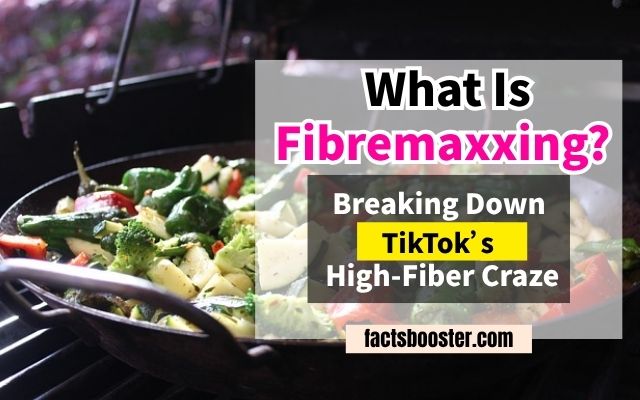What is Fibremaxxing? If you’ve seen TikTok videos claiming things like “lose belly fat in 3 days” or “poop daily in a week,” you’ve probably come across this viral trend. Fibremaxxing is all about loading up on high-fiber foods to boost digestion, reduce bloating, and feel lighter — fast.
Popular among those looking for natural fixes without exercise, it involves eating foods like chia seeds, lentils, oats, leafy greens, or fiber smoothies. But does it actually work? Or is it just another social media fad?
In this article, we break down what Fibremaxxing really means, what the science says, and how to try it safely (if at all).

What Is Fibremaxxing?
What is Fibremaxxing? It’s a diet trend that’s been going viral recently on TikTok and other social platforms. You’ve probably seen influencers talking about how loading up on fiber-rich foods can help you slim down, feel lighter, and “clean out your system” — fast.
The term “Fibremaxxing” combines “fibre” (dietary fiber) with “maxxing” (maximizing), and it refers to the idea of consuming large amounts of fiber to improve digestion, increase satiety, promote weight loss, and boost overall gut health.
This trend has gained massive attention, especially among those looking for natural ways to feel better, improve their digestion, or shed a few pounds without extreme diets or workouts. Common Fibremaxxing foods include chia seeds, lentils, oats, brown rice, nuts, and dark leafy greens — even trendy green smoothies or powdered veggie drinks count.
What makes these foods so appealing? They’re high in fiber, low in calories, and easy to incorporate into everyday meals. For many, it feels like a shortcut to a “cleaner,” healthier lifestyle — without the need to count calories or follow rigid rules.
Why Did Fibremaxxing Go Viral?
Fibremaxxing exploded in popularity thanks to the power of social media — especially short-form videos on TikTok. Countless creators began posting dramatic “7-day flat belly” or “3-day poop challenge” clips, featuring exaggerated before-and-after shots, easy-to-follow food swaps, and the irresistible promise of zero exercise. Naturally, people clicked, watched, and many were inspired to try it themselves.
For younger audiences in particular, Fibremaxxing seemed like the perfect formula: it looks natural, it’s simple to follow, and it seems to work — at least on the surface. No expensive supplements, no intense workouts — just a few changes in what you eat. Add in some fiber-rich foods, and you could see a flatter stomach, better digestion, and more energy.
Plus, it’s easy to make it look good on camera. Smoothie bowls, green lattes, veggie powder shakes — they’re colorful, Instagram-worthy, and easy to prepare. For people who want to feel healthier without overcomplicating their routine, Fibremaxxing quickly became the go-to trend.
The Truth Behind Fibremaxxing
Fibremaxxing might be a TikTok trend, but it’s rooted in real science. So, what is Fibremaxxing? It’s all about eating more fiber to boost digestion, feel fuller longer, and support healthy weight management.
Fiber helps keep you regular, balances blood sugar, curbs cravings, and feeds the good bacteria in your gut. It’s a quiet hero in your diet — not flashy, but powerful.
Experts recommend 25–35g of fiber daily, from real foods like oats, leafy greens, beans, apples, bananas, and seeds like chia or flax. The problem? Many people don’t even get half that. (1)
So yes — Fibremaxxing works when done right. Just skip the extremes and stick with simple, whole-food fiber. Your gut (and skin, mood, and energy) will thank you.
When Fibremaxxing Goes Too Far…
Yes, fiber is great for your health — but more doesn’t always mean better. With the Fibremaxxing trend heating up, many people are jumping in headfirst, loading up on chia seeds, beans, and veggie powders without understanding how much their body can actually handle. The result? A lot of uncomfortable side effects.
Common complaints include bloating, gas, cramping, diarrhea — or oddly enough, even constipation. That’s especially true when fiber intake increases suddenly without enough water. Without proper hydration, all that fiber can literally clog up your system and make things worse, not better. Some even try extreme methods like eating dry chia seeds or chugging fiber drinks multiple times a day — which may disrupt digestion more than help it.
And here’s the thing: Fibremaxxing isn’t for everyone. People with IBS, digestive disorders, seniors, and young kids may be more sensitive to fiber and can experience worsened symptoms if they follow the trend blindly. And let’s not forget — a lot of the “weight loss” people report in a few days is often just water loss or an emptied gut, not actual fat burning.
Bottom line? Moderation matters. Listen to your body, increase fiber gradually, and focus on balance — that’s how you’ll truly benefit from a high-fiber lifestyle.
How to Try Fibremaxxing Safely
Curious about Fibremaxxing? The key isn’t “the more, the better” — it’s all about easing into it and choosing the right combinations. A smart way to start is by gradually increasing your fiber intake, about 5 grams per day, while watching how your body reacts. Jumping in too fast can lead to bloating, cramps, or digestive discomfort.
Water is essential. For every 10 grams of fiber you eat, you should drink around 300–500ml of water. That’s because fiber absorbs water and expands in your gut — without enough fluids, it can actually back things up and make constipation worse.
Here’s how you can start Fibremaxxing in a healthy, practical way:
- Breakfast: Oats with fruit and a sprinkle of nuts — high in fiber, filling, and delicious.
- Lunch: Brown rice, lentils, and plenty of leafy greens — simple, whole, and gut-friendly.
- Snack: Chia seed pudding or a fiber-rich snack bar — portable and satisfying.
Be sure to avoid common mistakes: don’t rely solely on powdered greens or supplements, and don’t cut out protein or healthy fats in the name of “detoxing.” Also, skip the exaggerated claims like “lose 5 pounds in 3 days” or “flush out 10 years of waste” — those are just social media myths.
The truth is, Fibremaxxing only works when it’s part of a balanced, long-term lifestyle. Take it slow, stay hydrated, and let real food do the work — that’s the sustainable way to support your gut and feel your best.
So… Is This TikTok Trend Worth the Hype?
Fibremaxxing is essentially a high-fiber diet — just rebranded and boosted by social media. Thanks to TikTok’s viral nature, it’s sparked new interest in gut health and digestion. But what is Fibremaxxing, really? It’s the idea of increasing fiber intake to improve bowel movements, reduce cravings, and support weight management.
When done right — with balanced meals and enough water — Fibremaxxing can genuinely support digestion and appetite control. But the problem starts when people blindly chase extreme results or fall for overhyped claims like “flush out 10 years of waste.”
The truth? Health doesn’t happen overnight. Fibremaxxing can be a smart upgrade to your eating habits, as long as it’s based on science — not shortcuts. Fiber isn’t magic, but it is one of the most powerful (and underrated) tools for long-term wellness.


